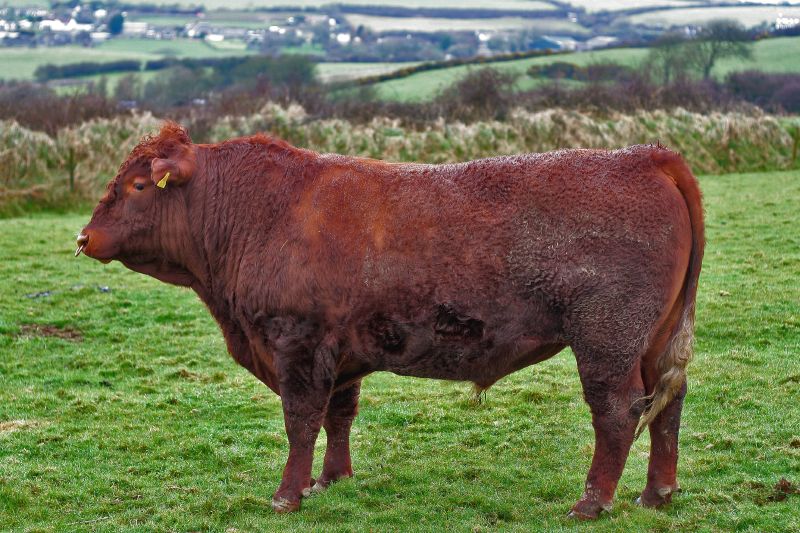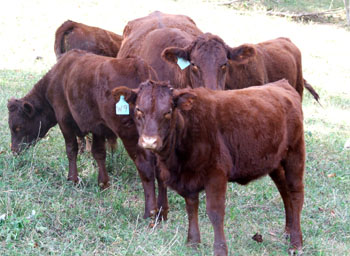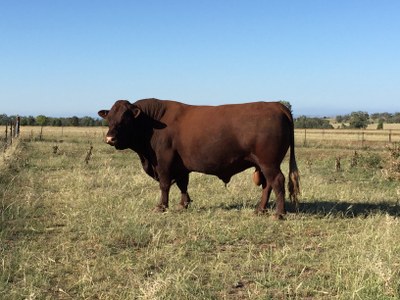Devon Cattle
 The Devon, sometimes called North Devon, to distinguish it from the South Devon breed,
is one of the oldest beef breeds in existence today. In fact some authorities consider
the Devon's origin to be prehistoric, the assumption being that the breed descended
directly from Bos lonqifrons, the smaller type of aboriginal cattle in Britain. In fact, according to an official
reference material compiled by the Devon Cattle Breeders Society, Somerset, England;
Devon Cattle - The Red Rubies, it appears that the Red Cattle of North Devon may have contributed to the Hereford
and other British breeds.
The Devon, sometimes called North Devon, to distinguish it from the South Devon breed,
is one of the oldest beef breeds in existence today. In fact some authorities consider
the Devon's origin to be prehistoric, the assumption being that the breed descended
directly from Bos lonqifrons, the smaller type of aboriginal cattle in Britain. In fact, according to an official
reference material compiled by the Devon Cattle Breeders Society, Somerset, England;
Devon Cattle - The Red Rubies, it appears that the Red Cattle of North Devon may have contributed to the Hereford
and other British breeds.
The Devon was previously classified as a dual-purpose breed. Over the past half century, however, the breed has--through selection--evolved as a beef-type breed which is registered and promoted by the Devon Cattle Association, Inc. A Milking Devon strain (unique to America) has been maintained and is represented by the American Milking Devon Cattle Association.
The native home of the Devon is in southwestern England, primarily in the counties of Devon, Somerset, Cornwall, and Dorset. For centuries, herds of red cattle grazed the grass covered hills of this cool, moist region. History records that the Romans took notice of the red cattle when they occupied this area in 55 B.C. There is some evidence that the seagoing Phoenicians may have brought some ancestral red stock from northern Africa or the Middle East to Southwestern England during their visitations for tin. Some animals breeders speculate that this might account for the Devon's remarkable adaptation to hot climates in spite of its centuries of exposure to the damp, chilly hills of England's Atlantic coast.
 The early improvers of the Devon breed were Francis Quartly and his brothers William
and Henry, and John Tanner Davy and his brother William. It is generally agreed that
Francis Quartly accomplished for the Devon what the Collings did for the Shorthorn.
Colonel John Tanner Davy founded the Devon herdbook in 1850. In 1884, the Devon Cattle
Breeders' Society was organized and took over the herdbook.
The early improvers of the Devon breed were Francis Quartly and his brothers William
and Henry, and John Tanner Davy and his brother William. It is generally agreed that
Francis Quartly accomplished for the Devon what the Collings did for the Shorthorn.
Colonel John Tanner Davy founded the Devon herdbook in 1850. In 1884, the Devon Cattle
Breeders' Society was organized and took over the herdbook.
Only 131 years after Columbus discovered North America, the first Devon cattle reached what is now the United States. The year was 1623. The ship Charity brought a consignment of red cattle (one bull and three heifers) from Devonshire to Edward Winslow, the agent for Plymouth Colony. These red cattle of Devonshire, brought in by the Pilgrims, were probably the first purebred cattle to reach North America.
During its long history in the United States, numerous breeders have been instrumental in bringing the Devon in America to a high degree of excellence. From the earlier dual-purpose type, beef conformation has been enhanced while retaining adequate milk production. Rate of maturity has been accelerated. The more common criticisms of light hindquarters and sickle hocks have been reduced to minimum. And, in keeping with newer concepts in America of "ideal" beef form, Devons have been made longer, taller, and trimmer but, fortunately, not to extremes as is true for some "exotic" breeds.
Although the Devon was originally a horned breed, American stockmen developed a polled strain of purebred Devons. It traces back to the bull Missouri 9097, a hornless "sport" or mutation that was born in 1915 in the purebred Devon herd owned by Case and Elling in Concordia, Missouri.
Devon cattle are red in color, varying in shade from a rich deep red to a light red or chestnut color. A bright ruby red color is preferred and accounts for their nickname, the "Red Rubies." The hair is of medium thickness and is often long and curly during the winter; however, coats are short and sleek in summer.
Modern Devons have adequate size and scale but are not "horsey" big. Mature bulls in good working condition weigh from 1700 to about 2200 pounds with a few in top flesh condition exceeding the later figure. Mature cows range in weight from about 950 to about 1300 pounds. Thus, Devons have enough size to be practical and profitable without the handicap of excessive maintenance cost.
 Calving problems are seldom encountered although a growing stress on using larger
bulls has increased the incidence of difficult births. Male calves average about 75
pounds at birth but may range from about 55 to 95 pounds. Heifer calves average about
70 at birth but may range from about 45 to 90 pounds.
Calving problems are seldom encountered although a growing stress on using larger
bulls has increased the incidence of difficult births. Male calves average about 75
pounds at birth but may range from about 55 to 95 pounds. Heifer calves average about
70 at birth but may range from about 45 to 90 pounds.
The functional characteristics of the Devon make them a valuable "genetic tool" for the commercial beef industry. The breed has long been noted for its fertility, calving ease, docility, hardiness and ability to adapt to temperature extremes. The well-developed heat-regulating mechanism of the scrotum of Devon bulls give them an unusual ability to remain fertile despite extremely high environmental temperatures.
Devons are active good "walkers" and are excellent rustlers and grazers. In England, they are known as "the Beef Breed Supreme at Grass." Their ability to efficiently utilize grass and other forages has heightened their popularity in areas like southern Brazil, Australia, and New Zealand.
Registries and Breed Associations
New Zealand
New Zealand Devon Cattle Breeders Association Inc.
P.O. Box 1702
Palmerston North
New Zealand
Email: isca@wave.co.nz
United States
Devon Cattle Association, Inc.
Jeremy Engh
9272 Big Horn Rd
Remington, Virginia 22734
United Kingdom
Devon Cattle Breeders
Mr Andrew Lane MRICS FAAV
Wisteria Cottage
Iddesleigh
Winkleigh
Devon EX19 8BG
UK
01837 810942
Email: lane@dcbs.fsbusiness.co.uk
References
Dr. Stewart H. Fowler, Beef Cattle Consultant, Milton, Florida 32570-4178
